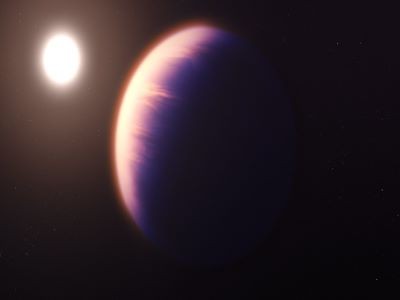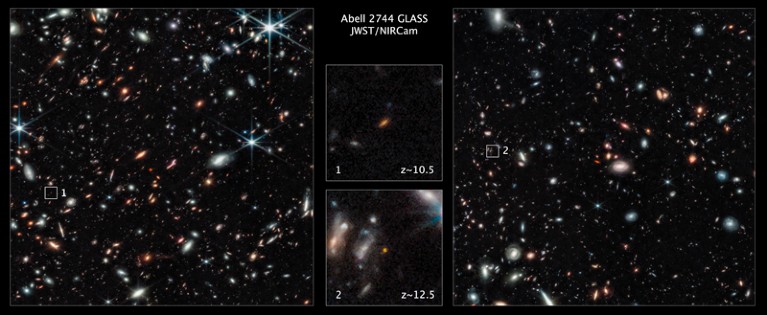
Using the new James Webb Space Telescope (JWST), astronomers have spotted two leading contenders for what could be the most distant galaxy ever seen. Both surfaced in the scrum of preliminary results that were posted online as preprints in the weeks after JWST started doing science in July. They have since gone through extensive scrutiny, including re-evaluation owing to updated calibrations for the telescope — and have now been published in peer-reviewed reports1,2, some of the first JWST results on the early Universe to do so.

Webb telescope spots CO2 on exoplanet for first time: what it means for finding alien life
Researchers still need to confirm the distances of these galaxies by analysing the spectral properties of their light. But if initial estimates are correct, light from these objects has travelled such great distances that they appear as they did just 350 million to 450 million years after the Big Bang. Along with other recent JWST findings, these observations indicate that galaxies formed and evolved earlier in the Universe’s history than astronomers had been able to probe until now.
“It’s been a bit of a surprise that there are so many that formed so early,” says Jeyhan Kartaltepe, an astronomer at the Rochester Institute of Technology in New York. And that is challenging notions of how galaxies formed early in the Universe, she says.
Like many of the other distant galaxies spotted by JWST, the two contenders for most-distant galaxy appear small and bright, suggesting they are compact, disk-shaped objects rather than being diffuse and straggly. Their tidiness and brightness hint that early galaxies had already developed well-organized structures out of many stars, rather than being distorted and faint as earlier studies with the Hubble Space Telescope had indicated.
“This is amazing — we are seeing such luminous galaxies at early times,” Garth Illingworth, an author on one of the new reports who is an astronomer at the University of California Santa Cruz, said at a 17 November press briefing.
A race for the record
JWST, a US$10-billion observatory, studies the Universe in infrared wavelengths. One of its specialties is being able to detect light from distant galaxies that has been stretched to redder wavelengths by the expansion of the Universe. Astronomers describe exactly how far away galaxies are by using a measure known as redshift, with higher redshifts indicating more distant objects. One of the now-published distant-galaxy candidates has a redshift of 10.4 or 10.6, while the second candidate has a redshift of 12.2 or 12.4. The latter breaks the previous record of a galaxy spotted by Hubble that has a redshift of around 113.

The final, published redshifts are slightly lower than those reported earlier in preprints. Like many early JWST results, the findings went through extensive re-calculation after the Space Telescope Science Institute in Baltimore, Maryland, released updated data calibrations for JWST starting in late July.
Many other distant-galaxy candidates from JWST are still working their way through the peer-review process. Some could surpass what is now the new record holder at redshift 12.4. At least one has already been spectroscopically confirmed at redshift 9.76, in a preprint posted on 27 October to arXiv.org4 — although it doesn’t break the distance record. That preprint is listed as being in submission to Nature.
Meanwhile, other researchers are looking more broadly at what JWST is revealing about galaxy formation. In a preprint posted on 10 November5, a team including Kartaltepe analysed 26 galaxies observed by the telescope with preliminary redshifts from 9 to 16. That work, too, finds that there are many more bright galaxies at these distances than theory had predicted. “While it is early days with JWST,” the authors write, “[initial] results provide an enthralling glimpse of the potential secrets the early universe has which our observations can unlock.”
"some" - Google News
November 18, 2022 at 04:14AM
https://ift.tt/PflVzHh
JWST spots some of the most distant galaxies ever seen - Nature.com
"some" - Google News
https://ift.tt/NoJCmS2
Shoes Man Tutorial
Pos News Update
Meme Update
Korean Entertainment News
Japan News Update
Bagikan Berita Ini














0 Response to "JWST spots some of the most distant galaxies ever seen - Nature.com"
Post a Comment